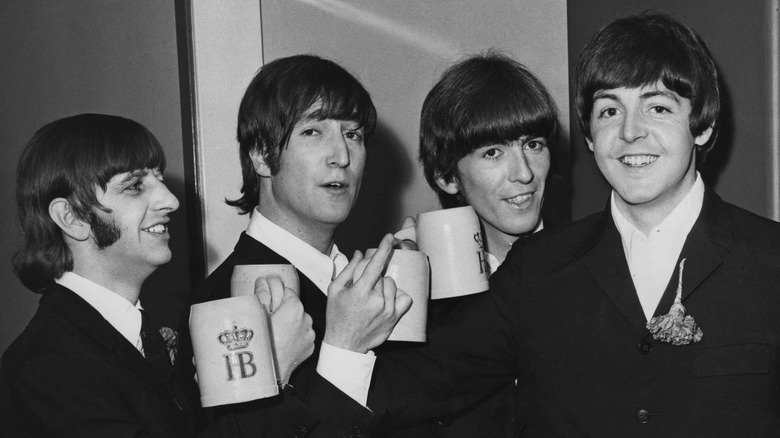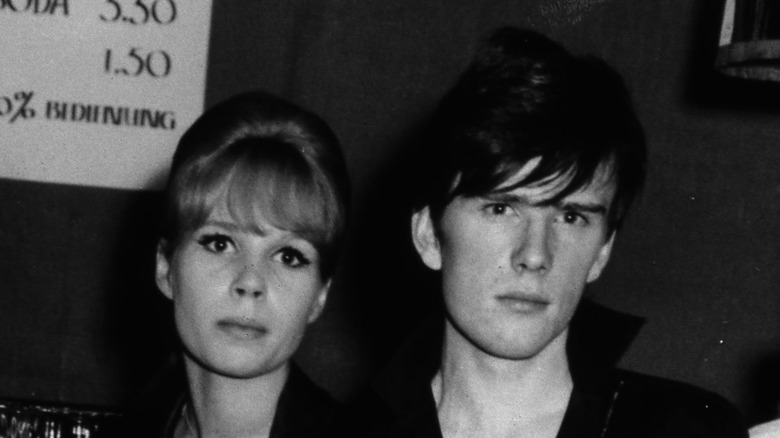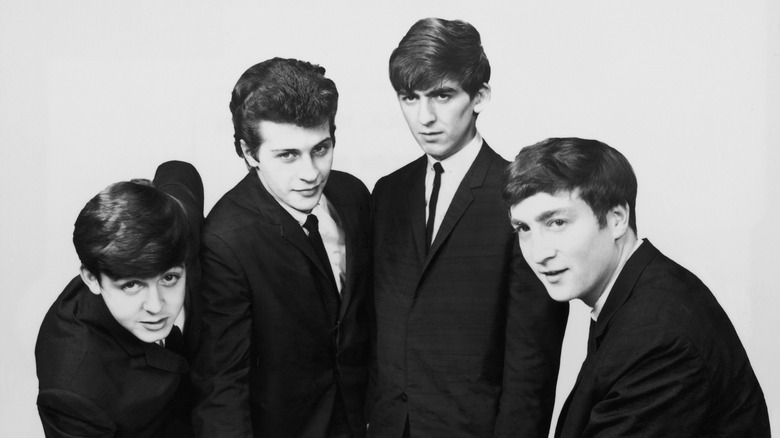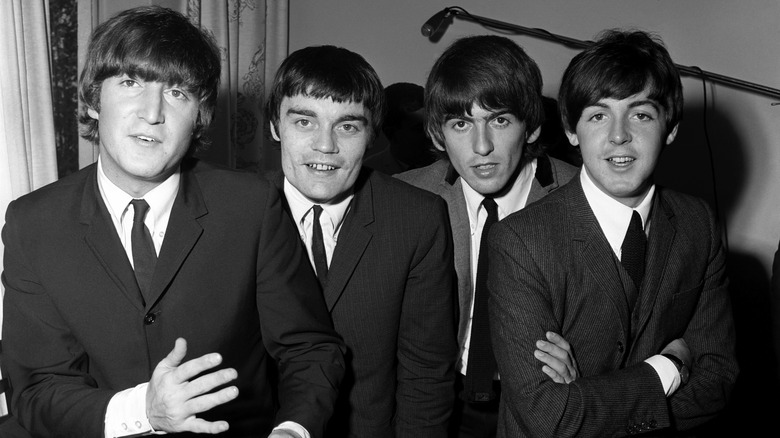The Beatles Actually Had More Than 4 Members In The Band
We may receive a commission on purchases made from links.
There are few bands in the history of popular music that the average person would recognize by their members' first names alone. But mention John, Paul, George, and Ringo to most people and they'll know you're talking about the Beatles. Sometimes referred to as the "four lads who shook the world" due to their seismic effect on the culture of the 1960s and music in general, their impact is still felt today. Most recently, Beyonce released a cover version of "Blackbird" from the Beatles' 1968 self-titled album on her 2024 release "Cowboy Carter."
John Lennon, Paul McCartney, George Harrison, and Ringo Starr each went on to have successful solo careers after the Beatles came to an end in 1970, but their time in the biggest band ever remains their defining work. They continue to attract new listeners and are known as the "Fab Four," while the dynamics between the individual members are still pored over by music fans. What was the truth behind the relationship between Lennon and McCartney? Was Harrison as angry about being sidelined by the other songwriters in the group as documentaries like "Let It Be" make it appear? Was Starr simply a very good drummer, or did he play a vital role in mediating tension between the other Beatles?
But the truth is that the Fab Four weren't the only people to play in the Beatles — in fact, the band didn't begin as a four-piece at all. While manager Brian Epstein, producer George Martin, publicist Derek Taylor, and assistant Neil Aspinall have all been called the "Fifth Beatle" down the years, five additional musicians were actually in the band or on the cusp of becoming full members at one point or another.
Stuart Sutcliffe
The Beatles made their name as a live act in the early 1960s on the club circuit in their native Britain and, famously, Hamburg, Germany. Their tours and residencies, typically booked by manager Brian Epstein, were grueling, with the band performing for hours on end. Such practice made them a tight unit, which paid off when they first rose to international fame.
Though they would come to be known as the Fab Four, the Beatles were originally a five piece. The band's bassist during their early years was a young man named Stuart Sutcliffe (pictured, right), a Scottish-born artist and musician who was raised in Liverpool and came to know John Lennon while studying at the Liverpool College of Art. Sutcliffe was reportedly a far better painter than he was a musician, and in 1960, Lennon and his bandmates convinced him to spend his earnings on a Höfner bass and join the band.
Despite lacking natural ability, Sutcliffe toured with the Beatles constantly and developed a rockstar look that helped attract audiences to their performances. His relationships with the other Beatles, who were jealous of his looks and success with women, were sometimes strained. One time he got into an onstage fight with Paul McCartney, reportedly over a German woman named Astrid Kirchherr (pictured, left). Sutcliffe was with Kirchherr, then his fiance, in Hamburg on April 10, 1962, when he suffered a fatal brain hemorrhage at the age of 21. His death was heartbreaking for the Beatles, particularly Lennon, and he was later memorialized on the cover of their album "Sgt. Pepper's Lonely Hearts Club Band."
Pete Best
Before Ringo Starr became the world's quintessential rock drummer — even though certain circles would suggest that he "was not even the best drummer in the Beatles" — there was Pete Best. Another Liverpool musician, Best performed with the Beatles during early live shows in Germany and the United Kingdom, including their legendary performances in the city's Cavern Club. He was still their drummer after they signed their first recording contract and can be heard on an early recording of the band's debut single "Love Me Do," as well as several songs that later appeared on the Beatles' "Anthology" compilation. However, he was forced out of the band in August 1962.
As with Stuart Sutcliffe, some claim that the other Beatles may have been jealous of Best's dashing good looks, though this wasn't the reason he was replaced. EMI producer Ron Richards and producer George Martin both didn't think his drumming was precise enough for a band planning on recording hit singles and believed Starr represented a major improvement in musical skill. Sutcliffe's look also failed to chime with the other members, who by then had adopted their signature mop tops.
Best was later able to capitalize on his former membership of the band, releasing an album playfully titled "Best of the Beatles" in 1965, though he left the music industry in the late 1960s. In 1988, he reemerged and forged a musical career of his own, performing regularly in Liverpool and beyond.
Chas Newby
The names of the next two one-time members of the Beatles are arguably the reserve of hardcore fans of the Fab Four. Nevertheless, they each played their small part in the Beatles story. Chas Newby — performing center frame in the video above — was a friend of Beatles drummer Pete Best and previously played with John Lennon in his former band, the Quarrymen. After all of the Beatles' members — bar Stuart Sutcliffe — returned from their stint in Hamburg in 1960, the group was looking for a stand-in bassist who could fill-in and allow them to continue gigging in the U.K. Newby fit the bill and played with them for a number of shows. Lennon was reportedly keen to keep Newby on as the Beatles' permanent bassist, but the truth was he never considered music a career — he was more interested in returning to college. After his stint with the band, Newby turned to teaching mathematics, though he returned to perform in a reformed version of the Quarrymen in 2016.
"People sometimes don't believe me when I say I've no regrets," he told the Sunday Mercury. "But I really haven't. I have enjoyed my life immensely." He died May 22, 2023, at the age of 81.
Jimmie Nicol
Jimmie Nicol's name is as obscure as Chas Newby's in the history of the Beatles. But unlike Newby, who was in the band before it was famous, Nicol played with them at the height of Beatlemania and found himself in the full glare of the media spotlight. Nicol (pictured, second from left) was a respected session drummer who had caught the attention of Beatles producer George Martin after playing sessions for an act called Tommy Quickly. In June 1964, the Beatles were on the eve of a major world tour, which would take them across Europe, Asia, and to Australia, when Ringo Starr was hospitalized with tonsillitis and pharyngitis and was unable to perform. The cost of canceling the tour was too great, and despite Starr's misgivings, it was decided to hire a stand-in. Martin suggested Nicol, who, having previously played on an album of Beatles cover versions, had no trouble learning the songs from the tour. He slipped into the band seamlessly.
"He did the job excellently, and faded into obscurity immediately afterwards," Martin said bluntly, per "The Beatles Anthology." Manager Brian Epstein provided Nicol with his pay for 10 shows and a TV appearance and gave him a watch with an inscription from himself and the band. "The boys were very kind but I felt like an intruder," Nicol later said (per "The Beatles Literary Anthology"). "They accepted me but you can't just go into a group like that — they have their own atmosphere, their own sense of humor. It's a little clique and outsiders just can't break in." He continued in the music industry for a while but later experienced bankruptcy before working various jobs and retreating from the public eye entirely.
Billy Preston
Billy Preston's experience with the Beatles started before they had found fame and culminated in one of the band's most famous moments. Preston first met the band in 1962 in Hamburg, when he was on tour with the rock 'n' roll hero Little Richard — a major influence on the Beatles. Years later, when the Fab Four had become megastars but found themselves in something of an artistic dead-end during the "Get Back" sessions, they encountered Preston again. With tensions in the band running high, turned to the keyboardist and organist to join them in recording sessions.
Preston's presence created a new dynamic in the studio, lightening the mood and helping the musicians focus on the songs instead of the strife between band members. John Lennon was reportedly keen for Preston to become a full-fledged Beatles, but McCartney vetoed the idea. Nevertheless, he came as close to joining the band as any musician had since their early days. The single "Get Back" was released as being performed by "The Beatles with Billy Preston," and he was at the keys when the Beatles played their final public performance together on the roof of their Apple Corps offices on London's Savile Row on January 30, 1969.
Preston later toured and recorded with the Rolling Stones and enjoyed a solo career that brought him a Grammy Award in 1972. He also continued to perform with members of the Beatles during their solo careers. Elsewhere, he contributed to the music of major acts including Johnny Cash, Ray Charles, and Red Hot Chili Peppers into the 2000s.



